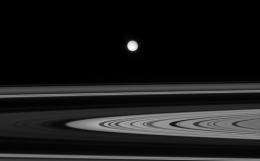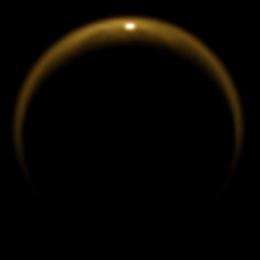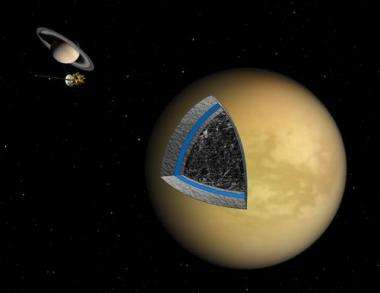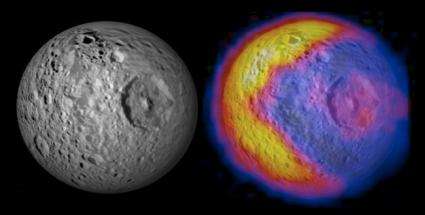The Magical Mystery Tour

Cassini, the first spacecraft to orbit Saturn, has revealed intricate details of the gas giant planet and its moons -- but many mysteries remain.
Six years ago, the Cassini spacecraft began orbiting Saturn and taking detailed images of its ring and many moons. While the Cassini-Huygens mission has helped answer questions about this planetary system, it also has revealed new mysteries for scientists to puzzle over.
One of the most important unknowns is the tiny moon Enceladus, which Cassini discovered has a plume of ice particles emanating from its south pole. If the plume is due to a reservoir of liquid water hidden beneath the moon’s surface ice, then where is the energy coming from to keep that water in a liquid state, rather than frozen solid? If Enceladus does indeed have liquid water, could it be kept in that state by the same processes that operate on the Jovian moon Europa, where the sea of water underneath the ice crust is kept liquid by the tidal kneading induced by Jupiter’s mighty gravitational field?
The Cassini mission has revealed other surprises too. Caroline Porco, director of CICLOPS, Cassini’s imaging system, says one of the most unexpected findings was the gentle corrugation in Saturn’s rings, starting at the D ring and found throughout the C ring. At the moment this is unexplained, but it may point to some event occurring on Saturn or within the rings back in the early 1980s. Like a dropped stone causing ripples to spread in a pond, we can still see the effects of whatever happened in Saturn’s rings 30 years ago.
Another mystery is the composition of the rings. Although the rings are 95% water ice the composition of the remaining 5% -- which imparts a reddish tint to the rings -- remains unknown.
John Zarnecki, principal investigator for the Huygens Science Surface Package, says another intriguing mystery is ‘the glint’ - the picture sent back by Cassini that suggests that there are seas on the surface of Titan.
At one time it was thought that the entire moon might be covered by an ocean of liquid hydrocarbon. The Huygens probe proved that was not the case, and in the process highlighted the greater mystery of the diversity of Titan’s various terrains. This in turn raises other questions, such as how can the thickness of Titan’s hydrocarbon atmosphere be maintained in the absence of a world-girdling ocean of the same material? Where does the atmosphere then come from? These questions still await answers.
Another mystery is the variation in time it takes for Titan to make one complete spin on its axis. This variation happens on Earth and Mars because of angular momentum changes caused by the varying densities of different fluids on or under the surface or in the atmosphere. On Earth, this effect slows down the rotation on our axis, lengthening the day by an estimated 0.0005 to 0.0035 seconds per century.

On Titan this rotational variability is interpreted to mean that the surface ice crust is disconnected from some other major physical component of the moon - possibly a subsurface ocean of ethane or methane. In the journal Science in 2008, Ralph Lorenz of John Hopkins University and colleagues suggested that Titan could have a frozen crust on top of a water-ammonia mixture, or even an entirely liquid water ocean similar to that suggested for some of the Jovian moons. If the crust is thin enough, and the ocean deep enough, then in theory Titan’s ice crust rotation could be decoupled from that of the moon's rocky core.
The scientists speculate that the root cause of the mismatch between Titan’s ocean and core comes from seasonal changes in winds - much like the case on Earth except that here the very large differences in mass of the planet and its atmosphere keep the effect almost imperceptible. Titan’s dense atmosphere and thin crust produce a more pronounced effect.
Most recently is the news from Mimas - also known as the Death Star because of the resemblance of the massive Herschel crater on the moon to the laser cannon on the space station in Star Wars.

A temperature map of the moon’s surface reveals extreme thermal variations, including unexpectedly hot regions. Scientists mapping Mimas’s surface with Cassini’s on-board infrared spectrometer found that the warmest region occurred in the morning, along one edge of the moon's disk, making a sharply defined Pac-Man shape, with temperatures around 92 Kelvin (minus 294 degrees Fahrenheit). The rest of the moon was much colder, around 77 Kelvin (minus 320 degrees Fahrenheit). A smaller warm spot - the dot in Pac-Man's mouth - showed up around Herschel crater, with a temperature around 84 Kelvin (minus 310 degrees Fahrenheit).
The warm spot around Herschel makes sense because tall crater walls (about 5 kilometers, or 3 miles, high) can trap heat inside the crater. But scientists are perplexed by the sharp, V-shaped pattern that resembles the famous 1980s computer game icon.
"We suspect the temperatures are revealing differences in texture on the surface," said John Spencer, a Cassini composite infrared spectrometer team member based at Southwest Research Institute in Boulder, Colo. "It's maybe something like the difference between old, dense snow and freshly fallen powder."
When the Voyager 1 and 2 spacecraft visited the Saturn system in the 1980s, their observations set the stage for the Cassini-Huygens mission. The Voyagers were just short-term visitors, passing through the Saturn system on their different pathways to deeper space. To really study the system in detail, a mission needed to remain there for an extended stay.

“While Voyager paved the way for the future exploration of the outer solar system, it is missions like Cassini-Huygens where the scientific riches lie,” says Carl Murray of Queen Mary, University of London. “This is because Cassini-Huygens is not a flyby mission where all the observations have to be squeezed into a few days around closest approach. Having an orbiting spacecraft means that we can not only make new discoveries, we can see the whole system evolve. As a result we can see things like seasonal changes in the weather on Titan, or monitor the development of new structures in parts of Saturn's rings.”
Now that the Cassini mission has been extended to 2017, scientists will have even more opportunities to see changes in the planet, its rings and its moons over time. The instrumental eyes and ears of the Cassini spacecraft will allow scientists to continue to examine the Saturn system at an unprecedented level of detail.
“We are learning a great deal about the processes involved in the creation, evolution and modification of planets,” says Porco. “The whole mission has given us many new insights into how planetary bodies work.”
Porco worked on the Voyager mission, and to her that mission was a completely different beast from Cassini-Huygens.
“Voyager was the pinnacle of romance,” she says, “a historical odyssey into the unknown.
With Cassini, we knew more or less what to expect and overall what we would encounter -- so in that sense, it wasn't anything like Voyager. But it's been visually and scientifically spectacular. For those of us Voyager veterans, returning to the Saturn system with Cassini was like having laser eye surgery. Everything now was so crystal clear. It was the sheer beauty of what we were seeing that grabbed us all so much.”
Source: Astrobio.net



















